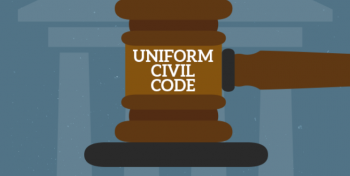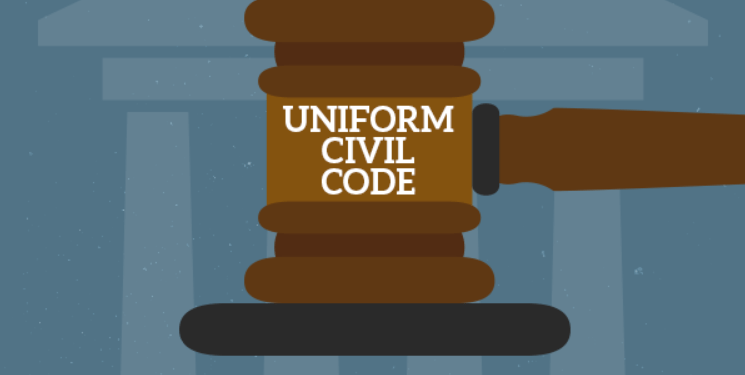
.png) Chhotebhai
Chhotebhai

TV debates and newspaper headlines are replete with news and views on the proposed Uniform Civil Code (UCC). They have generated more heat than light. That, sadly, may be what the UCC is all about.
Let us go by the facts, not opinions, especially those being bandied about by blind supporters of the BJP. While the UCC has been on the BJP’s agenda for ages it first took concrete shape in 2016 when it appointed Justice Dr Balbir Singh Chauhan (Retd) of the Supreme Court to the Law Commission. Justice Chauhan issued an Appeal with a questionnaire on 7/10/2016.
The wording of the Appeal was ominous. It sought to “Address discrimination against vulnerable groups and harmonise various cultural practices.” It desired that “No one class, group or community dominate the tone or tenor of family law reforms”. It was also concerned about women’s rights/gender justice.
The Appeal had sixteen questions most of which had to be answered in a yes/no binary; itself a simplistic approach for complex issues. One question each was addressed to the Muslim, Christian and Hindu communities. One was an odd question and the other twelve were ambiguous. Take Q4, “Will the UCC ensure gender equality?” How could anybody say yes or no to such a vague question?
Q7 was aimed at the Muslim practice of Triple Talak. It has since been declared illegal so the question itself has now become infructuous. Q8 seeks to know if “Steps should be taken to ensure that Hindu women are better able to exercise their right to property?” Was this not addressed by the Hindu Succession Act of 1956 piloted by Dr Ambedkar? It was amended in 2005. If there are still some anomalies, a simple amendment would suffice. Why this mammoth exercise of the UCC?
Q9 addressed to Christians is the most frivolous and possibly added to raise a non-issue. It asks if “the two-year period of waiting for finalizing divorce violates Christian women’s right to equality?” This is in reference to Sec 10A of the Indian Divorce Act 1869 that applies to Christians. Ironically, a High Court judgement had already reduced this “cooling off period” to one year. It pertained to divorce by mutual consent only and has no gender bias. So why is a mountain being made of a mole hill for an issue that has never been raised by the Christian community?
Q6 is the tricky one that seeks to know if the practices of polygamy/polyandry be banned or regulated? This loaded question is obviously aimed at the Muslim community, as the narrative has been created that Muslim men have five wives each. This assumption itself is wrong because if one man were to have five wives then four would be bereft of a spouse, neutralizing the equation in an already skewered sex ratio. The apprehension therefore is a baseless phobia deliberated perpetrated to defame the Muslim community. Ironically at the time of writing this (5th May) the Hindustan Times has a story of a man from Varanasi who had three wives, one of whom committed suicide as she couldn’t bear the deceit and trauma. The Allahabad High Court ordered that the husband be charged for abetting suicide. His name was not Ali or Ahmed, but Sushil Kumar, certainly not a Muslim-sounding name. Instead of insinuation, the government should check its own Census figures and ascertain how many Indians are actually polygamous and to which community they belong. Laws cannot be framed on wild assumptions alone.
The ultimate irony is that after receiving various responses to its questionnaire, the Law Commission held that preparing a UCC was neither feasible nor advisable. Yet the BJP bhakts persist with this demand. It is, therefore, obvious that the demand for UCC has little to do with gender or social justice and everything to do with vote bank politics.
Another false premise is that a UCC already exists in Goa from the time it was under Portuguese rule. If it could be implemented there, then why not in the rest of the country? What is conveniently overlooked is that Portugal itself has scrapped this law some years ago, as it is not in consonance with modern situations.
Former Foreign Minister, Eduardo Faliero, himself a Goan, wrote in Indian Currents in March 2017 that it was a fallacy to claim that the Goa Law was uniform. For example, while Hindus had the right of adoption, the Christians and Muslims did not. Another provision in Goa, known as “Communion of Assets” could stir more than a hornet’s nest in India. As per this provision, at the time of marriage the spouses become co-owners of each other’s property. A son-in-law would become a co-owner of his wife’s property. Would this be acceptable to Indian Society? We already have cases of bride burning and dowry deaths. Now an avaricious son-in-law would be sorely tempted to bump off his wife so as to grab her property. As the Prophet Hosea says, “When you sow the wind you reap the whirlwind” (Hos 8:7). Can better sense prevail?
Besides, there are several anomalies in Indian society, both cultural and legal. Let us examine some of them. Firstly, the Hindu Undivided Family (HUF). This is a special provision with tax concessions given only to Hindus. Will the UCC abolish the HUF privilege that is not in conformity with the proposed uniformity? Will the Hindu community accept the abolition of this privilege?
Another discrepancy based on religion is reservation for Scheduled Castes (Dalits). This is available to Hindus, Sikhs and Buddhists only. Dalit Muslims and Christians are denied this benefit. Will the UCC remove this anomaly and give equal status to all Dalits?
There is much talk of Article 44 of the Indian Constitution that perfunctorily states in just one line that “the State shall endeavour to secure for the citizens a UCC throughout the territory of India”. It is followed by this comment, “Uniform Law for all persons may be desirable. But its enactment in one go may be counterproductive to the unity of the nation.“ (Pannalal Bansilal Patil vs State of Andhra Pradesh, AIR 1996 SC 1023). These are words of caution and wisdom from the Supreme Court itself.
Much is also made of the abolition of Sec 370 that was applicable to J&K State, and seen as being discriminatory against outsiders. What about other similar constitutional provisions – 371 for Maharashtra and Gujarat, 371A for Nagaland, 371B for Assam, 371C for Manipur, 371D and E for Andhra Pradesh, 371F for Sikkim, 371G for Mizoram, 371H for Arunachal Pradesh and 371I for Goa? Bringing uniformity in all these diverse provisions would be tantamount to rewriting the Constitution of India itself. Is that the government’s hidden agenda?
Take also the Indian Penal Code. It too has diverse provisions for different States. For example, Sec 272 on Food Adulteration has separate provisions for Orissa, UP and West Bengal. Where will this “uniformity” begin and where will it end?
What of cultural diversity? The Khasis of Meghalaya are matrilineal with the children taking the mother’s name. For succession the youngest daughter is the inheritor. Will the Khasis abandon their ancient customs for uniformity?
Sikhs are permitted to keep their beards and wear kirpans and kadas. Muslims in the police force are also permitted to keep their beards. Will the so-called UCC throw the diversity among the people out of the window? More importantly, will Indian society accept this uniformity? I conclude with two analogies. Firstly, a small child wears a uniform when it goes to school, for a reason. By virtue of its uniform, it is easily identifiable and thereby protected. However, when that child grows up and goes to college it no longer uses a uniform. College students wear varied attire. It is indicative of their being responsible adults. The question therefore is “Do the advocates of the UCC consider Indian citizens as vulnerable children or responsible adults?”
My second analogy is of a coin. The Government Mint produces trillions of coins. They are all identical or uniform. But God the Creator has produced many more human beings, no two of which have the same thumb impression. For Aadhar Cards too, our retinal images are taken as no two humans have the same retina. This forces us to think – Manmade inanimate objects like coins can all be the same, but the Creator in its infinite wisdom made each human being unique.
Should the Government then treat us as inanimate objects with no intelligence of their own, or as diverse human beings made in the image and likeness of God? In that lies the answer to the UCC. It should not result in deforming a diverse society but should respect cultural, social and religious diversity. As the Law Commission itself said – “No one class, group or community should dominate the tone and tenor of family law reforms”.
(The writer is the Convenor of the Indian Catholic Forum)